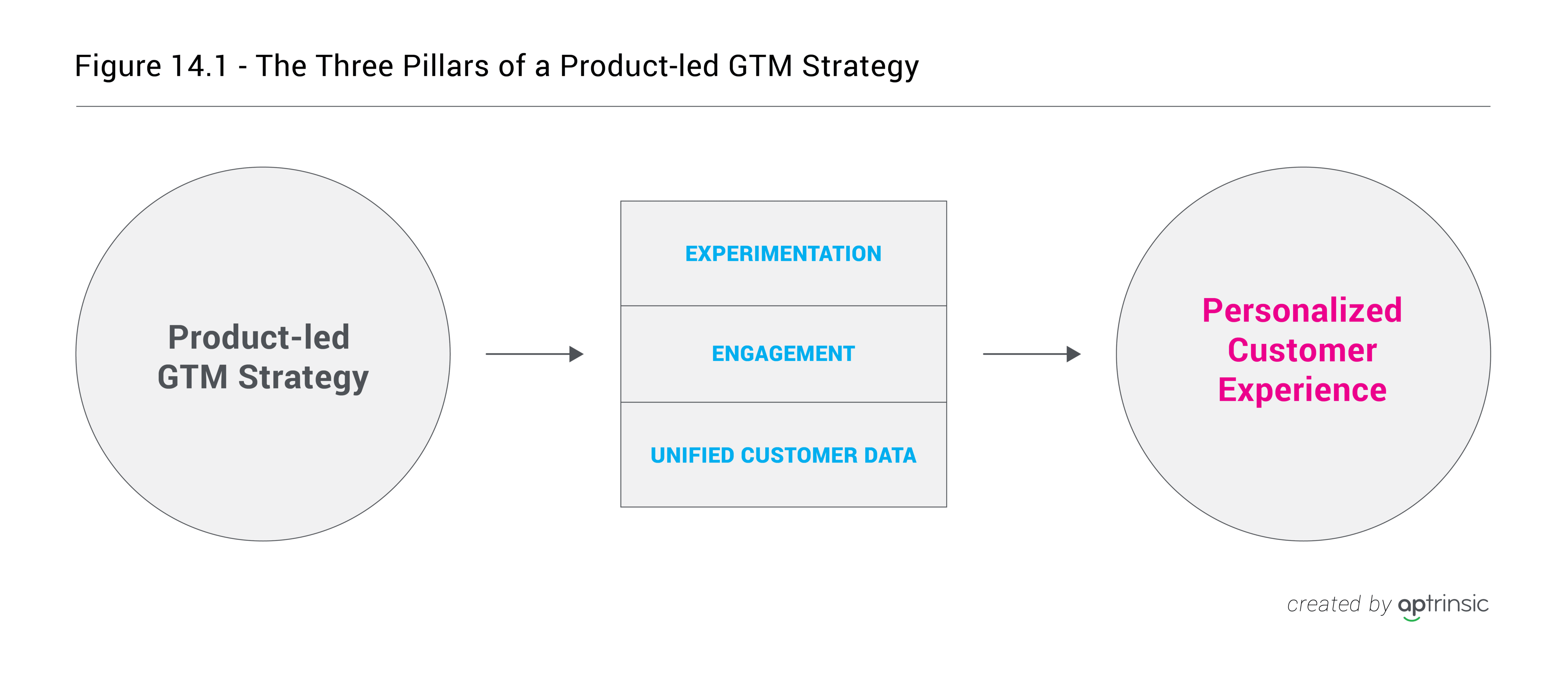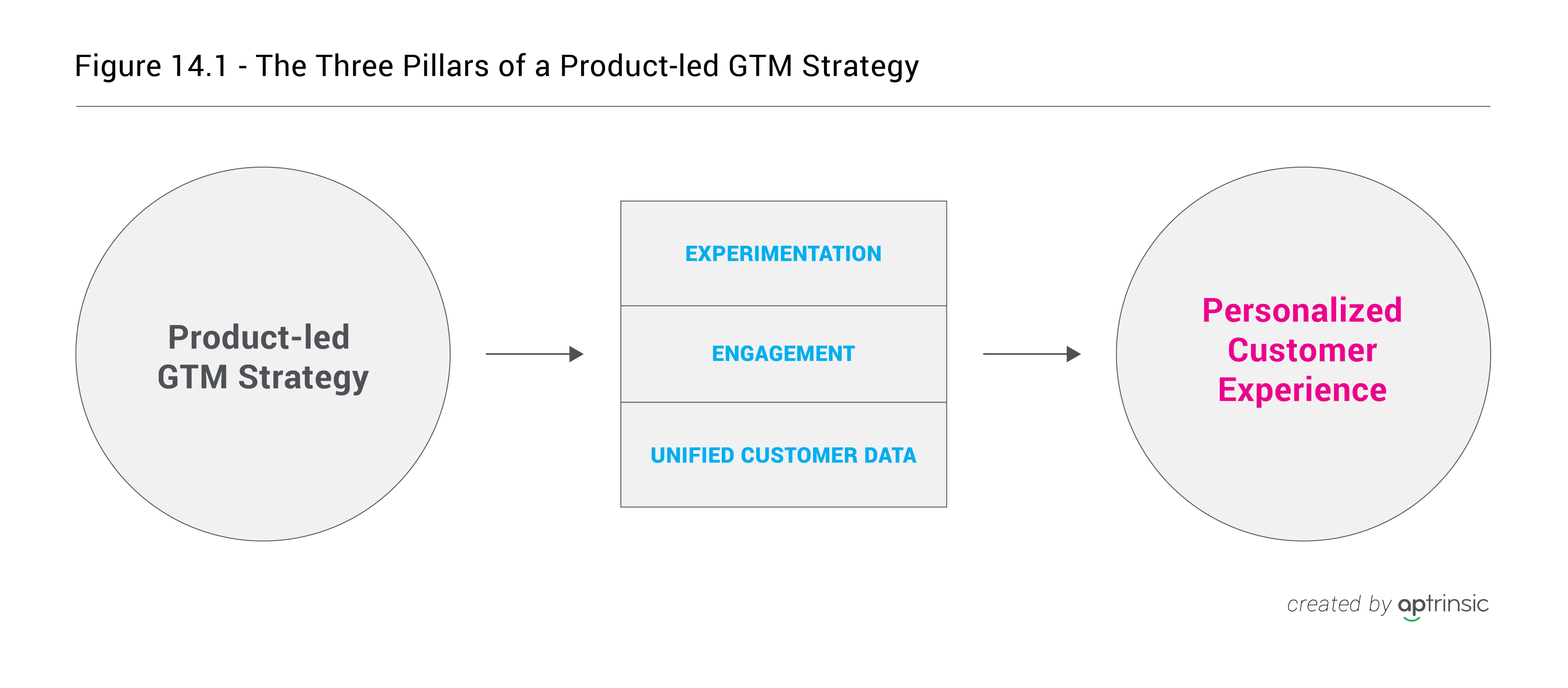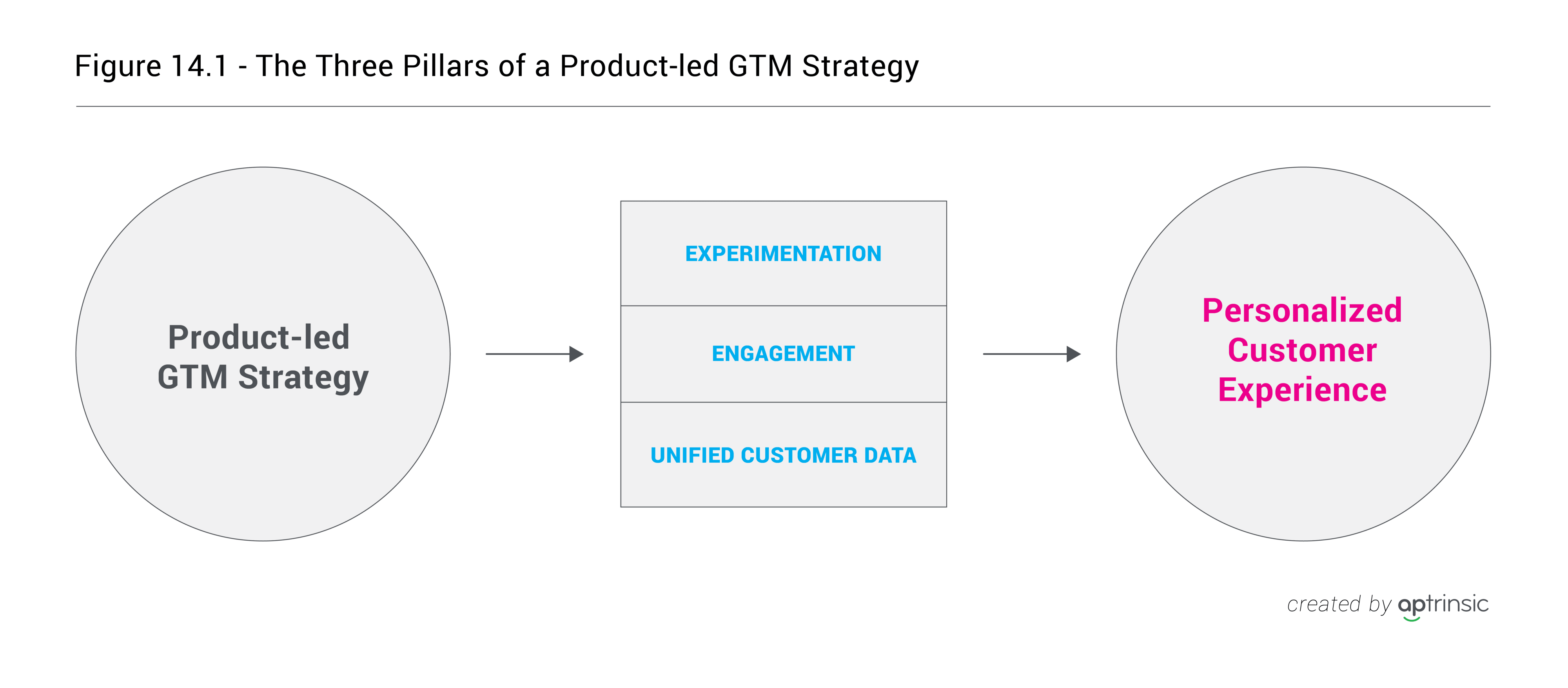Chapter 14: Three Pillars that Support a Successful Product-led GTM Strategy


A product-led GTM strategy provides a new framework for how leading SaaS organizations think about taking products to market and acquiring, retaining, and growing customers in a repeatable, scalable way.
Top management must get behind this approach to ensure the whole organization is supporting personalized customer experiences. We’ve discussed a few ways that product-led strategy enables companies to focus on personalized customer experiences. Let’s cover three pillars that are essential to delivering these experiences:
- Data & Analytics
- Engagement Capability
- Experimentation
But first, answer these questions:
- Can your organization track, integrate, and analyze comprehensive customer profile and behavioral data?
- Can your organization create automated and near-real-time, omnichannel engagements based on available customer data?
- Can your organization experiment with product features, messages, and engagements in a timely manner with minimal risk?
If you answered “no” to one or more of these questions, it’s critical that you put in place the following elements to support your product-led GTM strategy.

14.1 Pillar #1: Data & Analytics
According to the 2016 “Businesses @ Work” report by Okta, an average organization uses 13 cloud applications. Many of these cloud solutions create or store customer profile and/or behavioral data. At the same time, most organizations still rely on a combination of on-premise and cloud-based applications to capture and store this information (such as CRM, marketing automation, customer support, and customer success solutions). The challenge for many organizations is to aggregate customer data across all systems of record, no matter where they reside.
It’s not about dumping all available data into one data warehouse. It is not enough to know that a user with a certain e-mail logged into your product. Teams should also be aware, for example, of how much a customer is paying, as well as how many team members are using the product and the number of open support tickets attached to the account.
The cornerstone of a successful product-led strategy is understanding:
- Holistic customer experiences
- Where they are in their customer lifecycle
- What journeys have been completed
- Details about customer experiences across multiple interactions
Comprehensive customer data should include customer profile data (demographics), customer behavioral data, and production data. When it comes to this data, it must be comprehensive, intelligent, timely, and actionable. Let’s explain what we mean by each of these.
Comprehensive
Does our data tell us about every experience that a customer has with our company, brand, and product?
Intelligent
Does our data answer important business questions, and have we analyzed it for meaning?
Timely (a.k.a. Real Time)
How quickly is this data collected and analyzed to enable us to respond to individual customers, as well as see market trends in their early stages?
Actionable
Can we create contextual engagements with individual customers in a timely manner based on our data?
We have discussed the importance of understanding your customers by developing a 360-degree view of them; but often, organizations are stuck with what we call “forensic data” — data collected long after the fact and not comprehensive or actionable.
Let’s use a real-world example that highlights the importance of providing product managers with unified customer data. We won’t name the company, but this story was shared with our team as we interviewed product managers.
In this company, over 50 percent of customer success and customer support issues were related to a single problematic product feature. Because the company was dedicating so many resources across departments to support this feature, the company wondered whether it was better to remove it from the product. To make this decision, the product manager had to estimate the potential impact on customers and revenue. Specifically, the company needed to figure out which customers used this feature, how often, and the combined revenue of customers using the feature. Then it could decide which customers could be lost with minimal impact to overall revenues. This analysis proved to be difficult.
The manager had to match product usage data from a product analytics solution with customer/account data from a CRM system. That took a couple of days. Then, he had to answer a list of questions (i.e., which customers used this feature, how often, and so on) to determine how much revenue was associated with a particular feature.
Ideally, your product manager could handle this exercise much more efficiently. Your data management and analytics system should be able to answer how many prospects signed up today and failed to complete a journey to realize initial value.
14.2 Pillar #2: Engagement Engine
Data and analytics are not enough to personalize customer experiences. Your company needs the tools and capability to act on data in a timely manner. The cost of delayed customer engagement is the loss of context and customer interest. Here are two tactics to improve the effectiveness of customer engagement: automating personalized engagement, and omnichannel engagement delivery.
Automating engagements
Automating customer engagements with behavioral-based triggers can help teams shorten response times and ensure contextual engagements (the right customer at the right time with the right message via the right channel). If your customer and product data and segmentation are housed in one place, you can call upon a single system (i.e., engagement engine) to act on this data. This enables you to create engagement and respond quickly to behavior-based triggers. An example would be reminding someone via e-mail to log in to your app when they haven’t done so within a set period of time.
Omnichannel experience
Omnichannel experience is a critical part the new customer experience era. Not only do products need to be experienced consistently across multiple devices, communication with prospects and customers — from in-product notification to e-mail reminders — has to be smooth across all channels including mobile apps.
The following are two common challenges to creating effective omnichannel engagement:
- Efficiency: Can the organization create one engagement campaign and deliver it simultaneously across multiple channels?
- Consistency: Do your customers have consistent experiences when they engage with your campaigns or messages?
Here’s an example of consistency: Let’s say a customer dropped out of a journey on a desktop browser. Your campaign should bring that person back to complete the journey the same place they left off, whether they rejoin using a desktop browser or a mobile app.
14.3 Pillar #3: Experimentation
Colonel Tom Kolditz, professor and head of the Department of Behavioral Sciences and Leadership at the U.S. Military Academy, said that no plan survives contact with the enemy. When it comes to the personalized customer experience you deliver as part of your product-led approach, customers can be very unpredictable and unforgiving. The key is to be proactive and quickly respond to customer behaviors and changing needs.
Companies that learn from their customers and iterate fast will be more successful than those that don’t. That’s why experimentation has become mandatory in a SaaS environment. But experimentation is not just about conducting one-off A/B tests. Your company needs to conduct experiments on a large scale, and in more automated ways. For example, you could create onboarding experiences for three or four customer segments and test each newly signed-up customer in real time, and adjust your onboarding flows accordingly.
A product-led GTM strategy is the most effective way for your company to deliver the personalized customer experiences that are essential for long-term growth and success. An effective product-led strategy hinges on the ability to assemble and manage a 360-degree view of your customers’ data, engage in real time consistently on all channels, and experiment at scale to accelerate how you learn and adapt to customer needs.
